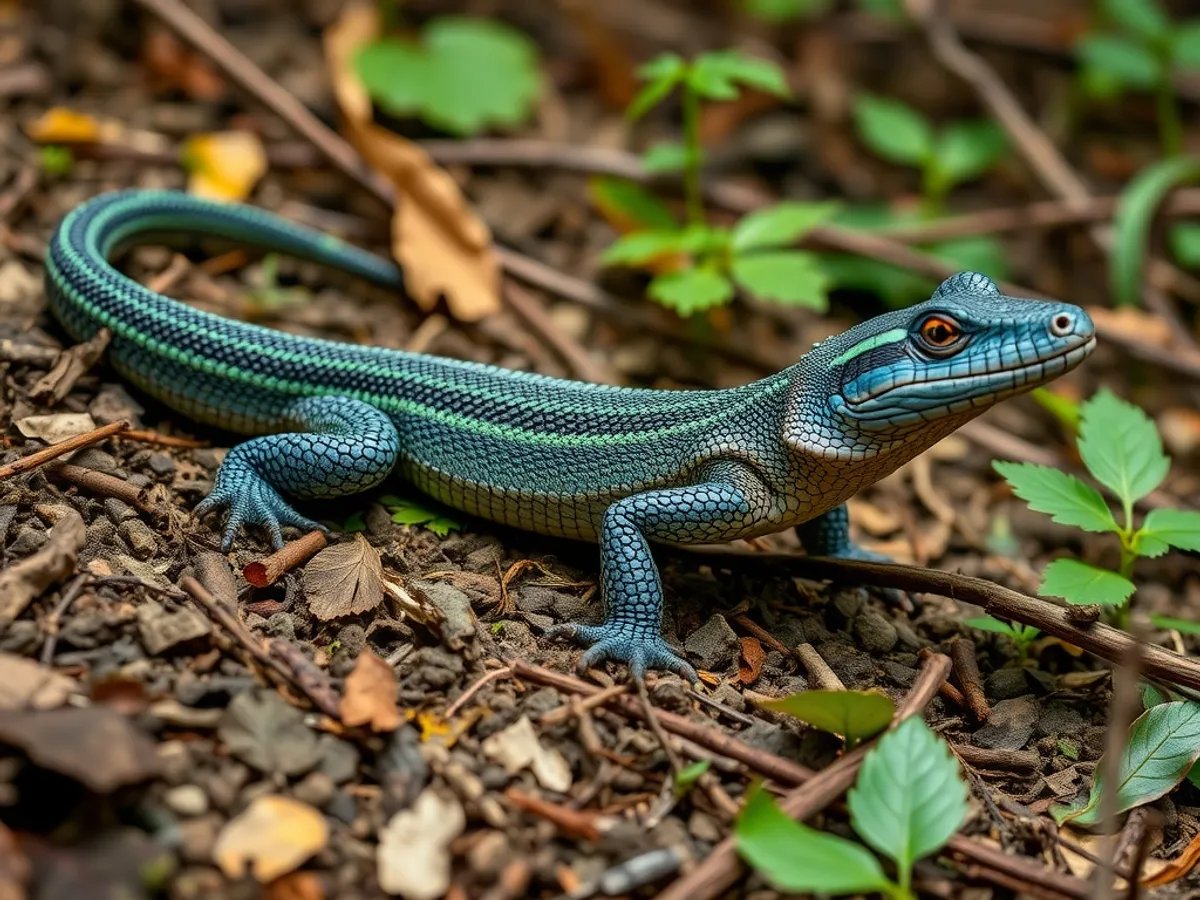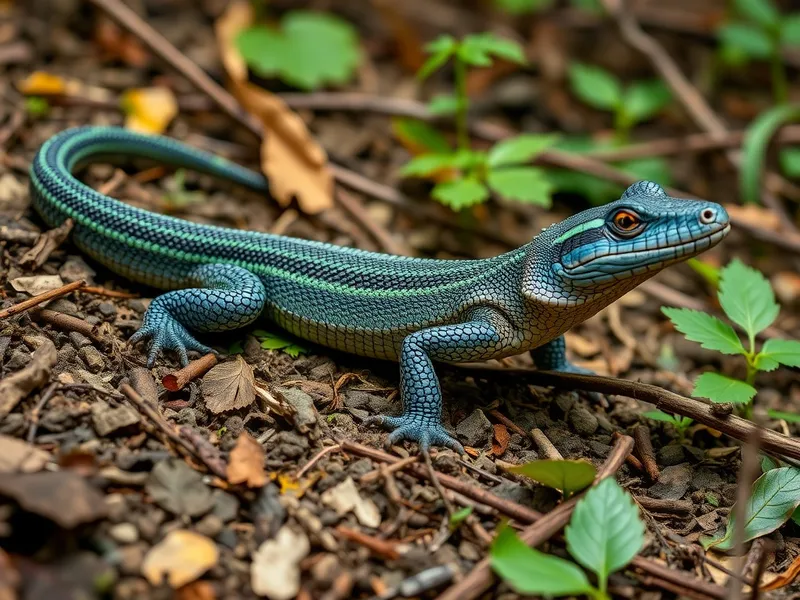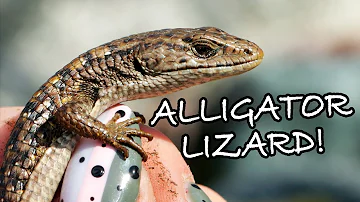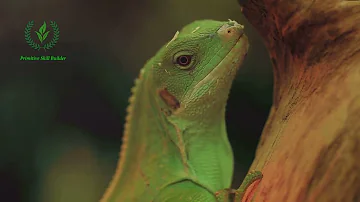
Northern alligator lizard
Elgaria coerulea

Meet the Northern alligator lizard
The Northern alligator lizard is a slender, medium-sized reptile native to the Pacific Northwest of North America. Characterized by its keeled scales, long body, and distinctive lateral fold along each side, this lizard typically displays a brown or gray coloration with dark crossbands. It thrives in moist forests, woodlands, and grasslands, often hiding under rocks, logs, or leaf litter. Adaptable and secretive, the Northern alligator lizard is primarily active during the day and can exhibit impressive tail autotomy as a defense mechanism.
Classification
Reptile
Habitat
Temperate forests and woodlands
Diet
Carnivore
Lifespan
5-10 years
Conservation
Least Concern
Weight
10-20 grams
📖Fascinating Facts
Tail Autotomy
When threatened by predators, the Northern alligator lizard can detach its tail, which continues to wriggle and distract the attacker while the lizard escapes.
Forest Dweller
This species prefers cool, moist habitats such as forests and woodland edges, often hiding under logs, rocks, or debris.
Live Birth
Unlike many reptiles, the Northern alligator lizard is viviparous, meaning it gives birth to live young instead of laying eggs.
📋Detailed Description
The Northern alligator lizard (Elgaria coerulea) is a medium-sized anguine lizard, typically measuring 18–27 cm (7–10.5 in) in total length, with the tail often comprising more than half its length. Its body is elongated and somewhat dorsoventrally flattened, with robust limbs and a distinct lateral fold of skin running along each side, which allows for flexibility and expansion during respiration or after feeding. The dorsal scales are keeled and granular, providing a rough texture, while the ventral scales are smoother. Coloration varies from grayish to brown or olive, often with 9–13 dark crossbands on the back and tail; the ventral surface is usually pale yellow or cream. The head is wedge-shaped with a pointed snout and relatively large eyes, adapted for foraging among leaf litter. This species possesses a prehensile tail capable of autotomy (self-amputation) as a defense mechanism against predators. Northern alligator lizards are secretive and primarily terrestrial, but they are also adept climbers, sometimes found in low vegetation. They are ectothermic and rely on basking to regulate their body temperature, often emerging during the morning or late afternoon. Their cryptic coloration and secretive habits make them difficult to spot in their natural habitat.
💡 Did you know?
Despite their name, Northern alligator lizards are not related to true alligators; their name comes from their rough, armored appearance and elongated body.
🔬Research & Sources
Wikipedia Summary
The northern alligator lizard is a species of medium-sized lizard in the family Anguidae. The species is endemic to the North American west coast.
Last Modified: 4/12/2025
🎭Behavior & Social Structure
Northern alligator lizards are diurnal, with peak activity during cooler parts of the day, such as morning and late afternoon, especially in spring and fall. They are solitary and territorial, using chemical cues and visual displays to communicate and establish dominance. When threatened, they may flatten their bodies, gape their mouths, or flee into dense cover; tail autotomy is a last-resort defense. Their diet consists mainly of small invertebrates—such as spiders, beetles, crickets, snails, and caterpillars—but they may also consume small vertebrates like juvenile rodents or other lizards. Foraging is typically active, with individuals searching under debris or within leaf litter. During colder months, they enter brumation (a form of hibernation) in underground refuges or beneath logs and rocks. Social interactions are limited outside the breeding season, though males may engage in ritualized combat during courtship.
👶Reproduction & Life Cycle
Breeding occurs in spring, typically from April to June, following emergence from brumation. Males locate receptive females using pheromonal cues and may engage in courtship behaviors such as chin rubbing and gentle biting. Northern alligator lizards are viviparous, giving birth to live young rather than laying eggs—a rare trait among North American lizards. Gestation lasts approximately 2–3 months, with females giving birth to 4–15 offspring (average 5–10) in late summer (July–September). Neonates are fully independent at birth, measuring 5–7 cm (2–2.75 in) in snout-vent length, and receive no parental care. Sexual maturity is typically reached at 2–3 years of age.
🛡️Adaptations & Survival
Key adaptations include the lateral fold, which increases body flexibility and allows for expansion during feeding or respiration. The keeled dorsal scales provide protection and camouflage among rough substrates. Tail autotomy is a critical anti-predator adaptation; the detached tail continues to wriggle, distracting predators while the lizard escapes. Viviparity is an evolutionary adaptation to cooler climates, allowing embryos to develop internally where temperatures are more stable. Their cryptic coloration and secretive behavior reduce predation risk. Additionally, their ability to brumate enables survival through harsh winters in northern parts of their range.
🎨Cultural Significance
The Northern alligator lizard does not have significant roles in indigenous folklore or mythology, but it is occasionally referenced in local naturalist literature and educational programs as a representative of Pacific Northwest herpetofauna. Its presence in gardens and parks has made it a familiar species to residents in parts of its range, sometimes regarded as beneficial for controlling insect pests. There are no known traditional medicinal or utilitarian uses.
🔬Recent Research & Discoveries
Recent research has focused on the evolutionary significance of viviparity in Elgaria coerulea, with studies indicating that live-bearing may have evolved in response to cooler climates and shorter breeding seasons. Genetic analyses have revealed significant population structure and the existence of several recognized subspecies (e.g., E. c. coerulea, E. c. palmeri, E. c. principis, E. c. shastensis), each adapted to specific microhabitats. Ongoing studies are investigating the impacts of urbanization and climate change on distribution and reproductive timing. There is also interest in the species' role as a bioindicator for forest ecosystem health due to its sensitivity to habitat alteration and pollutants.
🎥Wildlife Videos

Just a Minute: Northern Alligator Lizard
Check out the most charming little alligator (lizard) you ever did see—on a Preservation Trust preserve. See our entire series of ...
San Juan Preservation Trust

Wildlife - Just Reptiles | Free Documentary Nature
Wildlife - Episode 3: Just Reptiles | Wildlife Documentary Watch 'Wildlife - Episode 4' here: https://youtu.be/SNRyvGzDsww ...
Free Documentary - Nature

The Alligator Lizard Saga
A fun, five-minute "mini-documentary" about an alligator lizard that made her nest in a little cave on my outdoor model railroad.
raydunakin

Gator Country (Full Episode) | Florida Untamed
#FullEpisode #FloridaUntamed #NatGeoWILD About Nat Geo Wild: National Geographic Wild is a place for all things animals and ...
Nat Geo Animals

Herping Northern Alligator Lizards in British Columbia
Northern alligator lizards are a common reptile on the coast of British Columbia that can be found sunning themselves on rocks in ...
Life of Linda Lee

100 STUNNING California Reptiles You Won't Believe Exist
100 STUNNING California Reptiles You Won't Believe Exist Welcome to our latest adventure where we delve into the incredible ...
Primitive Skill Builder
🌍Habitat Information
The Northern alligator lizard typically inhabits Temperate forests and woodlands environments. Northern alligator lizards have adapted to their environments with specialized features and behaviors.
Primary Habitat:
Temperate forests and woodlands
More detailed habitat information will be available soon.
🛡️Conservation Status
The Northern alligator lizard is currently classified as Least Concern. Conservation efforts are crucial for preserving this species for future generations.
Common Threats:
- 🏠Habitat loss and fragmentation
- 🌡️Climate change impacts
- 🎯Hunting and poaching
- 🏭Human-wildlife conflict
⚠️Threats & Conservation Challenges
Currently, the Northern alligator lizard is classified as Least Concern by the IUCN due to its wide distribution and stable populations. However, localized threats include habitat loss and fragmentation from urban development, logging, and agriculture. Road mortality, predation by domestic cats and dogs, and the introduction of invasive species (such as bullfrogs) can also impact populations. Climate change poses a long-term threat by altering habitat suitability and the timing of brumation and reproduction. Despite these challenges, the species demonstrates considerable adaptability to disturbed habitats, including suburban gardens and parks.
🔬Scientific Classification
Scientific Name
Elgaria coerulea
Classification Hierarchy
🔍 About Taxonomic Classification
Taxonomic classification is a hierarchical system used by scientists to classify and organize living organisms based on shared characteristics and evolutionary relationships.
The system moves from broad categories (Kingdom) to increasingly specific ones, with each animal's scientific name typically consisting of its Genus and species.
📝Community Notes
Share your observations and insights about the Northern alligator lizard with our community of wildlife enthusiasts.
Join Our Community
Sign in to share your observations and connect with fellow wildlife enthusiasts.
Sign In to ContributeNo community notes yet
Be the first to share your observations about the Northern alligator lizard!
Explore Northern alligator lizard
Select a tab above to learn more about this amazing animal.
📸Photo Gallery
No photos available for this animal yet.
🌟Discover More Wildlife
Continue your journey of discovery with more fascinating animals from our database
